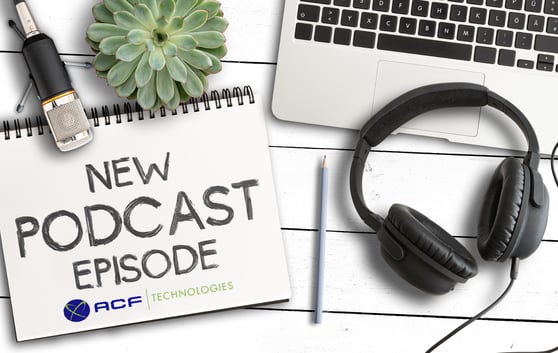With the introduction of new technology, such as 5G, Wireless devices, the Internet of things and the countless different customer engagement channels to come along with it – integrating all these effectively with your branches could get complicated.
A great example now of a highly versatile channel is Amazons Alexa, which you can now book appointments from at your local branch.
Utilising these new channels are not simple. It takes a highly organised and adaptable infrastructure to facilitate it, and every customer has their own communication preferences. Some would like to book an appointment in person or through the telephone, while others on their phone, or even through their Alexa. All these channels need to flow through the same system to work properly.
Episode 03 Summary
Are any of these channels “gimmicky” rather than practical in the long term?
A very important thing to keep in mind when implementing this technology is to clearly define how it is going to benefit the customer and the business. Make a commitment to your customers experience. This new technology implemented should not hinder the experience in any way.
Chat bots are widely disliked by customers because they are a hindrance, creating an entirely new process prior to being able to speak to someone from customer service. This adds significant friction to the customers journey and is often very poorly implemented.
Another example of a poorly implemented feature was Amazons virtual assistant on its Fire Kindle tablet. A feature where with a press of a single support button you could get in contact with support via a video call. It sounds good – but it was swiftly discontinued.
Are virtual/remote assistants something banks could use?
Remote assistants are something already being utilised by some of our customers. These video-based appointments have one highly specialist member of staff not available at one location, for example a mortgage specialist. At the other location is the customer and they are connected via dedicated video call rooms.
You do not need large call centres for this kind of process to work, just the correctly arranged systems and technology. There is huge amounts of opportunity in the banking sector for similar kinds of innovation.
Watch Adams customer journey for an example of true omnichannel experience.
Do you think these new channels will help banking institutions retain customers?
In the past, moving banks was a difficult process. Its very straight forward currently, and you can set up an account with some banks in minutes. It has become increasingly competitive; many banks now even offer monetary incentives to transfer your current account to them.
Retaining customers is more important than ever. And if all the branches on the high street begin to offer video conferencing functionality, and appointment booking to its customer, and your solution is low quality and ineffective - there are very little barriers to prevent that customer from leaving and going next door.
Opening new channels must be done correctly, and that should help retention. But if you do not do this correctly, you are putting your business at risk.
More effective insights and information on each customer
The most frustrating action you may do as a consumer dealing with a multi-step enquiry of some description, is having to constantly repeat yourself multiple times to multiple people.
To prevent this experience, all information gathered needs to be stored appropriately through a single view of that customer. All staff, across locations and functions will then have access to the same and most recent information on the said customer.
Let’s say Jeff wants to ask why a cheque has bounced. One day he visits the Woking branch and calmly asks what happened? and when will it be sorted?
The next week he visits the Guildford branch, because it’s close to his workplace. He asks yet again why his cheque has not been cleared… just to be met with the same response as the previous week in the Woking branch.
Jeff is going to be frustrated by this and will probably not be calm for much longer.

(Source - https://www.graphic.com.gh)
However – if instead, all the information of the first encounter in Woking was logged and stored properly. The 2nd interaction would have been unexpectedly smooth, more personal and would facilitate the development of a meaningful relationship between Jeff and the representatives of these two branches.
The difference is how the bank stores and leverages very simple information given by the customer.
Interaction management when the planned interaction does not happen.
Quite often, an appointment made by a customer results in a now-show. This is completely normal and is not always the fault of the bank to ensure the customer makes it to the meeting. Life gets in the way.
However, for most appointment systems we have replaced… a no-show appointment just ends up in a management data report 2 weeks later, with the enquiry being finished there.
One way we have mitigated this is by real time process automation, such as sending out a request to a call centre, or a branch representative. That way, especially if you are a high priority customer, you can almost always get the appointment rescheduled.
Customer service as a digital challenger bank
Digital only banks, such as Monzo and Revolut – have a very clear strength over traditional banks, and that is pure agility and simplicity of the banking experience. Targeting very specific age groups and demographics who are increasingly expecting a less restrictive and flexible experience. Digital banks make it incredibly easy to transfer funds to and from accounts and manage your finances in a way you have chosen.
This trumps the common regulations and red tape experienced in traditional banking. However what these digital banks lack is a face to face, human feel to the experience.
The human behind the great banking experience
Digital banks will never be able to provide the same level of emotional intelligence with their customer service. This basic level of human understanding and empathy is something that is strictly limited to another person.
A simple smile goes a long way in customer experience. Especially if the enquiry is of a negative nature.
Another benefit of physical stores and staff is the ability to hold meaningful events surrounding specific topics. By implementing an enterprise event management strategy, you can fully utilise the branches you have and the highly skilled staff – to create a memorable, and educational experience for your customers.
A great example is hosting a first-time buyer event, or a mortgage 101 with your branch’s specialist. This is an incredible way to build rapport with your customers, Skyrocketing brand reputation.
More episodes

Full episode transcript
Optimising multiple channels
Louis: Welcome to another episode of customer experience conversations and to part two of the retail banking challenges. In this episode we talk about how banks are optimising multiple different channels and the challenges and opportunities associated with interaction management. This is Louie speaking and I'm joined by Greg and Adam.
Greg: Hello.
Adam: Hello.
Louie: This episode is going to be about a few more problems the financial industry is experiencing at the moment. To start off, Adam, you were just talking about an experience you've had with the Alexa.
Adam: Oh yeah.
Greg: Not a rude one though I hope.
Adam: We were talking about obvious before we started this. I think it was, Greg actually mentioned it that if we have the ability to integrate with Alexa and I was quite mind blown if I'm honest. I mean that's incredible because in my, own house, I think I've probably got something like six Alexas scattered around, which is quite sad. Yeah, rigged up to my security cameras outside, my light bulbs, in the kitchen, my heating, everything. So, I'm probably one of those guys that's like into IOT and getting everything all integrated. And then Greg said that one thing that banks could actually potentially do using us, is if you were to connect it via security, have the ability to be like, you know, make an appointment with my branch. And I think that's incredible. That would be unbelievable being able to do that. And if we've got the technology all of that, I think that's something that should definitely be looked into. People more and more now, are more into getting into information.
Greg: Yeah.
Adam: We're all quite lazy and I use my Alexa all the time, many people probably don't use their Alexa or it goes off randomly without them knowing about. I personally think it's a fantastic little bit of kit and I think if you can integrate that in with the financial market, I think it'd be fantastic.
Louie: It's just one of many new communication channels that banks and other companies are starting to utilise.
Greg: Yeah, it doesn't stop there does it? Unfortunately, with Alexa and that's only one of many. Obviously, there's loads of like home device products that are entering the market and becoming extremely popular. But to me, it's just something I was talking about with a bank the other day. It's just, it's just one of new, many new channels that are opening up. Every organisation has to always think about or decide which channels do I wish to offer engagement through. You have to weigh up, obviously whether your customers are there. Is there a demand for it? Obviously, the overhead and cost to start operating down that channel. Social media for example, is another more modern channel and every platform is different. Do you want to engage with your customers by Twitter? Do you want to engage your customers via Instagram or Facebook? Because the moment you do, like if you're a large enough organisation, it's going to take time, money, energy and resource. You know, one of the things that I engage with an organisation is TFL. So, through Twitter, I follow TFL on Twitter for any updates, for example, on the trains.
Louie: Okay.
Greg: And if there's ever a problem with the train or you know, I noticed for example, recently I noticed there was, I think it was something like a broken light or really badly rattling sound. Everyone's sort of sitting there moaning and you know, huffing and puffing about it. I just went straight on Twitter. I gave the carriage number, I gave where I sat and said there's a really bad rattling sound, and can you sort it? I said I'm on the met line, it's just left Amersham or Chesham at this time. And they said this is absolutely fine. We'll get it sorted.
Adam: So rather than complaining about late trains, you actually help them out.
Greg: Yeah. Just so odd.
Adam: Rare man, Greg.
Greg: Thing about that, that is so easy. Like I've just potentially helped fix a problem with the company. But in order for that to happen, TFL had to make the decision as, yes, we want to engage with customers via Twitter for example. For them that's not a hard decision. But for other organisations, and when we are talking about Alexa, we're talking about social media channels of other types. To me, one of the challenges that faces banking is that if you do want to do it, you have to do it properly. It has to be secure, for example. That's a massive thing. You can't just send your bank details over Facebook, right?
Louie: Five-year-old suddenly talking to your Alexa and accessing your bank account.
Greg: Exactly. Yeah, exactly. So, there's all these things to think about and I think it's one of the great challenges, but it's also a great opportunity. So just try and flip it on its head. It's a really big opportunity I think, in the banking sector about really getting that right.
Louie: Do you think any of these channels are more gimmicky than practical and might fade out in the long-term?
Greg: The answer has to be yes to some level. I would say one that in particular that I haven't seen a huge amount of organisations get 100% right is automated chat bot
Louie: Yeah.
Greg: I think that's...
Louie: Nobody likes those.
Greg: Yeah. I don't think many people do like it and I think the ironic thing is actually it's, it's not a technology that helps. It's more seen as a technology that hinders.
Adam: Yeah.
Greg: Whenever you speak to anyone who's had to interact with an organisation through an automated chat bot, annoyingly, you sort of feel like you're having to go through this process so I can actually speak to someone. It's like having, it's like calling up on a phone and then having to answer the questions and then you finally get the option, where "would you like to speak to representative?" And you say "yes". It feels like a similar thing and I remember it was actually at RBR, the banking event, I think it was last year. Someone did a really good talk about how in their organisation they really were focused on any technology that gets implemented. It must not hinder the experience in any way, shape or form.
Louie: Yeah
Greg: Even if it improves the business hugely, they said they made it like a commitment to their customer experience. Was even if it benefits was massively as a business, if it remotely hinders the customer experience, then they need to reconsider, and I like that.
Louie: Absolutely.
Greg: And I like that methodology and I think sometimes, that's what, you know, any decision you make, whether it's communications or any part of your business, obviously you are weighing up internally versus externally, how it is going to benefit customer and business. But communications probably at the moment is such a hot topic because new channels are always opening up and yeah, Alexa is one of them.
Louie: Yeah. Similar to a chat bot, you can see some companies using virtual agents.
Greg: Yep
Louie: I think Amazon did it first and they provided a button at the top of their Fire, their Amazon Fire Kindle. Is that what called? And you'd press it and you'd immediately get through to a virtual agent, which you could ask a question to. Unfortunately, that wasn't successful in the long-term for Amazon. But do you think that's something banks could implement into their business model?
Adam: Yeah. To me it's about just improving the utilisation of the staff that you have. I don't think you need to bring on new staff in any way, shape or form to have virtual agents. I'm sure using technology where I know using technology you can already just set that up with the staff that you have. One of our customers, for example, does video-based appointments and it's simply because the resources that serve those appointments, the staff members are highly trained skilled staff members and they're not available every branch. So, what they do is they get customers, for example that want the appointment to speak with that member of staff. The customer actually comes to one branch, the skilled member of staff goes to another branch and they actually connect through a dedicated video room on either side. So, our solution for example, is booking out in the room. It's broken out the equipment. It's obviously sending all of the communications to both parties internally and externally to make sure that, you know, that all gets lined up. But that's just a good example of how virtual agents does it. There don't need to be this whole big overhaul of your business and you need to implement, you know, some dedicated call centre with everyone on cameras. You can actually just do virtual agents with your existing staff. And same way actually, we actually, one of the things that we do in that manner is when you've got appointments, some of those appointments for example, that you can do face to face, some of them you could offer call centres. But there's no reason to say why members of staff in the branches cannot also answer phone calls. So, with a lot of our solutions, we route first of all to a call centre, but then if a call centres aren't available, immediately we start putting that call around to different call centres for someone else to answer. Because obviously a phone call doesn't care where you're based, so you can utilise resources like that as well.
Louie: Yeah.
Adam: Communications.
Greg: Yeah, a lot of challenges, a lot of opportunity in the banking sector in particular. A lot of underlying governing rules but very interesting space.
Louie: Yeah, definitely. And these new channels that will definitely help banks with keeping customers in the long-term and that's seems to be a challenge nowadays, keeping customers at your bank. In the past it was a lot more difficult to move banks.
Greg: Yep.
Louie: But nowadays it's becoming a lot more accessible to quickly change to a new bank.
Greg: Yeah,
Adam: I think banks, if anything they might almost be victims of their own success on that because in terms of moving bank accounts, as you just kind of said, it is actually relatively simple now. And in fact, banks actually advertise or they suddenly used to, how easy that was and how to move your direct debit, standing orders. Some of them even incentivise you to move. Retaining customers for banks is probably as important as ever if not more important than ever. And one thing just touching on what we just talking about in terms of communications, I think if you were to implement anything new, it needs to be done correctly and it needs to be done right because you know these customers, if all of a sudden all the high street bank started offering, you know, web conferencing, the ability to suddenly make an appointment with your bank manager or an advisors' department, if you have a solution that you launch that isn't robust and isn't stable or good, that customer will leave. Because obviously, you know, this generation and newer generations are more in demanding of quick information, getting information whenever they want it. We don't really like waiting. We don't like those chat bots. Because I agree with you guys, I think things like chat bots are just, they're just modern-day call attendance and they're just another obstruction need to get the answer that you want. As long as the bank is open to new channels and as long as they do it correctly, that should actually increase retention. But if they don't do it correctly, then they actually put themselves potentially at risk. But it's like anything, if they don't evolve and offer them, I think they're in trouble anyway. So, I've just got to really put the research in and do the testing on it.
Louie: Definitely important to make sure that each customer is getting a good experience with this technology. Do you think there's anything else that can affect the customer's experience that the bank can do? Like more information, more insights into the customer?
Adam: In any industry, banking, retail, whatever it is, I think the biggest frustration is being a consumer and end user, is having to repeat what you're doing. If you ever think of any incidents in a person, your own personal life, whenever you've had a problem and you've had to phone someone, log into an app, go on a chat bot, go on a live chat. One of the biggest frustrations is actually having to repeat something that you've done. And what the banking industry should certainly be trying to do is any information that is gathered, every bit of information that you gather is incredibly important. Bringing that information and making it available at hand straight away to any agent that's dealing with them is massive because you know, if I was phoning up my local bank or if I was logged into an app or if I popped in, if just from my account number and sort code or my credentials, they could find out the most recent time I spoke to them; when I had a complaint; if I didn't have a complaint; if I'd opened up a new service. I think it would be very good customer service, very strong customer service to actually ask me about that experience, whether it be a positive conversation or a negative one. In the end that it's always going to increase my customer experience with them. Using information from previous experiences, whether it be face to face on the telephone, on an app, I think that's essential. Putting in one place, that'd be really helpful.
Louie: Yeah. Using this information in that way, it sounds simple, but it's actually a lot more complicated than it sounds. You have to implement an effective single view of your customer. And if you don't do that, then you've fallen at the first hurdle. You can't capture that information.
Adam: And it needs to be real time because imagine if you had a single view, which was a week behind time. And if you look at all their transactions, things that they've done and you think they're all tickety boo and happy, but it turns out actually they were in branch A the day before going up to the crazy advance money, but you didn't have the information there. It could actually be again, can be quite embarrassing.
Greg: Yeah.
Adam: definitely.
Greg: You look quite silly as an organisation.
Adam: They would, yeah,
Greg: I think that's a really good point. I really liked your idea there around just utilising quite simple information. Like you say, putting bunch of systems in place. It's just using simple information to really ensure that your staff are, you know, giving that personal feel to the experience. And that's not hard. Like that's not a hard thing to do. If you are able to create one to one relationship between, you know, members of staff and customers, that's fantastic. Sometimes, obviously with the rotation of staff, et cetera, that's not always possible with a lot of staff as much as possible. But you can implement technologies and solutions like that where you do put immediately to the member of staff. Yeah. Information they can see and that gives them context to who they're speaking to. And I also think that another idea, I guess to throw out there to the audience and saying that we've done it quite a lot of our customers, is to help harness retention, to help boost retention. When you have interactions and in particular appointments are very applicable. It's often about handling an interaction when it does happen, but there's also an element of handling interaction when it doesn't happen or if a customer doesn't show up for an appointment. And in my experience, it's really something that so many organisations overlook. They often implement an appointment booking solution, whether that's ours or someone else's, but there's just no thought about or no implementing a strategy about what do I do if a customer doesn't show up. For nine out of 10 at least, the customer solutions that I see where for example, we are replacing the solution, nine out of 10 organisations I speak to the have solutions in place right now. They literally, any customer that doesn't show up, it ends up in a report that's viewed by management two weeks later and nothing's done about it.
Adam: That's crazy.
Greg: Whereas the way that we mitigate that is in real time by immediately sending call, stop call, or call tasks to the call center agents to say call the customer or maybe to the branch manager or to someone to say, you need to get in touch with this customer. They didn't show up for an appointment and that's just the start. You can get extremely advanced on this because you can start to send additional notifications to certain levels of staff depending on what level of customer they are. So, for example, if they're a business customer and they've got lots of loans or they've got, for example, let's say they're a large property investor and they've got five or 10 or 20 mortgages with you, they're pretty important. And not to be horrible to other customers, but they're probably more important to you than other customers. And I know we don't want to admit that because I don't have 10 properties or anything like that, but to you as a business, that's a more important customer. And I don't think necessarily you should hundred percent treat every customer exactly the same because certain customers have more needs and requirements and therefore it makes sense to use business automated processes like that or just ideas that we just talked about to help increase the retention around customers, especially customers that are you know, a high risk to you if you do lose them. So yeah, there's lots of, there's lots of ideas around how to boost retention. To me, it normally just starts with the simple things really and implementing them well. I think is a good...
Louie: Customer centricity.
Greg: Yup, exactly.
Louie: One thing I was thinking about just before this podcast is the level of customer service that these challenger banks would be providing. Do you think they would have the ability to, if you wanted to call a member of staff and talk to them like you would with your bank? HSBC Burpees sometimes, they.
Greg: yeah.
Louie: Can you do that with them? Do you guys know much about how Monzo works?
Adam: Personally, I actually do use one of these other banks as well. I originally took out the account actually because it was free to do and I did it for when I was traveling around, travelling holiday because it's much easier to load like a Revolut card or a Monzo or whatever. And we've actually, I topped my revenue card up with my Google pay account, just done on my, on the fly, on my mobile phone. I then know if I pay via contact lists or take money out in the States or whatever. I know I'm getting probably a better rate than if I just took it out of the cash point. We've only ever card and that's all I've used it for so far. So, I don't actually know personally what you, you know they do have a customer service centres. Very, very good question. Greg, do you, do you use any alternatives?
Greg: I have a Monzo account, but I don't use it very much. I'm a newbie to that, but it's like any area of business. The fact that you're more mainstream banks have these new challenger banks that are branchless, they're all digital, naturally. Of course, they really are appealing to a certain age demographic, a certain type of customer. But there's still a lot of other customers that don't know about those banks, don't trust those banks yet. So, I don't think, I don't think they've won the battle at all. But I also think that thinking both positively for them and for the challenger banks, both types of organisation have strong points and strengths that the others don't for the challenger banks, their strength for sure. There's lies in the pure agility and simplicity of the banking experience. Whereas other larger banks, they've been established for years and years and years and years have inbuilt processes and regulations and bits and pieces that makes it makes the life sometimes a bit harder for the customer. But what a mainstream bank can tend to offer of course with physical locations is that face to face interaction or human feel to the experience.
Louie: If I was a business customer with lots of real estate and loads of loans like we spoke about earlier, I probably would not use one of these digital challenger banks as my first choice.
Greg: Sure.
Louie: Because I would like to know that there are people behind my account.
Adam: [Inaudible] because even if you look at Revolut, as a big example, they're massive, you know, the FinTech space, they are one of the biggest. If you look at their consumer brand and their consumer app, which everyone uses with a card, their ratings extremely high. You look at their Revolut business, it's two out of five. So, I think you're bang on that at the moment. Whether that changes in the future, I don't know, but at the moment that you really are spawn
Greg: And it comes back to something we talked about and I think the previous episode to hear about the idea around using physical stores for not just appointments but things like events, massive, massive trend right now in retail banking, you know. Utilizing the branches that you have, the staff that you have hosting events around, very niche specific topics. Again, that's something that these challenger banks just can't do. In theory, yes, they can because they have employees. It's not like they don't have employees and obviously they can do a pop-up event anywhere they like, but in reality it's not happening as much. And if you're someone like a Santander or Barclays where you have hundreds, sometimes thousands of branches, your coverage is ginormous. You have the locations, you have the staff already. If you implement the appropriate event management or enterprise event strategy, then there's nothing to say that you can't create those experiences, which again is just a differentiator between you and these banks. And yeah, I think it's also, the final thing I guess to add from my perspective on this challenger banks is, you know, the simple value of something like a smile goes a long way in customer experience. It's so often overlooked. But I heard a great quote by someone once and it was someone who interviewed Steve Wynn and lots of people know Steve.
Louie: The guy who runs the Casinos in Vegas. He's got a life for himself.
Greg: He owns the Wynn hotel and the Encore hotel in Las Vegas and I'm sure he owns lots of other hotels as well. But ultimately someone wants it to him, what's your hiring process? How are you able to hire, I'm sorry, how was your training process? How are you able to train your staff to be so happy? And he said, I don't train my staff to be happy. I hire happy people. And it was just such a simple message and I was like, that's comes from one of the most successful business people of all time. And it was such an important message that actually probably nine out of 10 customer challenges or cost a bad customer experiences could be easily resolved with just a simple smile.
Adam: A hundred percent.
Greg: Because a lot of the time we're interacting with customer, sorry, we we're interacting with organizations somewhat in a negative sense. You know, we've got a problem with our contract or we've got a challenge with our bank or you owe us a refund and it hasn't come through. We don't normally reach out to our bank to tell them how great a job they're doing. It's normally because we've got a challenge, we've got a problem on something as simple as a smile or you know, a basic level of understanding around your customer to give that level of empathy to the experience, to me is often overlooked. And again, going back to the original topic of conversation where we've got challenger banks versus, for example, more traditional banks, traditional banks going to win for a long time in my experience.
Louie: They can't provide that level of emotional intelligence in their customer service. They never will be able to, you can't automate feelings.
Greg: No, exactly.
Adam: Absolutely not.
Greg: Exactly. I think that's good. Hopefully we shared some ideas there and just things to think about, I guess for the audience in terms of another couple of key challenges that, you know, the banking sector face. Anything else you wanted to cover today or should we, should we save some more for the future and hopefully.
Louie: We've got plenty more to talk about.
Greg: Perfect.
Louie: So, tune in next time. You're good.
Greg: Thanks.







